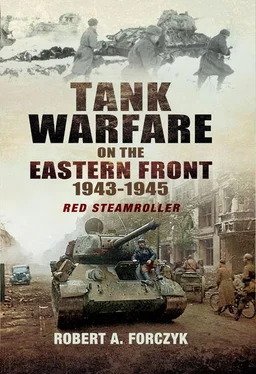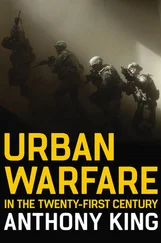While Hoth’s month-long delaying action served to save Heeresgruppe A from isolation in the Caucasus, it came at a high price in men (almost 4,000 casualties) and equipment. The commitment of Tiger tanks in this sector had only provided Hoth with a temporary tactical advantage and while the three Tiger companies managed to knock out a total of at least 39 Soviet tanks, only five of 29 Tigers were still operational after just two weeks of combat. In contrast, the ability of units such as Balck’s 11.Panzer-Division, equipped with just a handful of Pz III and Pz IV medium tanks, to conduct a mobile delay and inflict reverses upon much larger pursuing Soviet mechanized forces offered far more cost-effective value to the Ostheer. On the other side of the hill, the performance of Sharagin’s 3 GMC on the offensive, the tactical defence and pursuit had been exemplary – indicating a steady improvement in the Soviet practice of mechanized warfare. Yet it was also clear that the Red Army had not mastered the art of logistical sustainment in mobile warfare, which caused its spearhead units to run out of fuel and ammunition at the worst possible moment. Even elite guards mechanized units were forced to use Panje carts in their support units and at least half the infantrymen in the mechanized brigades rode atop tanks as desantniki , all due to the scarcity of trucks.
The Crisis of Heeresgruppe Don: Gruppe Hollidt, 1 January–14 February 1943
While Hoth’s panzers were delaying Eremenko’s drive to cut off Heeresgruppe A, Gruppe Hollidt was struggling protect the eastern approaches to Rostov from Vatutin’s Southwest Front. Rostov was the anchor for the entire German position in southern Russia and the supply lines for both von Manstein’s Heeresgruppe Don and von Kleist’s Heeresgruppe A ran through the city. Throughout December, Gruppe Hollidt’s primary mission had been to defend the airfields at Morozovskaya and Tatsinskaya, from which the Luftwaffe was conducting the airlift missions to the encircled AOK 6 at Stalingrad. However, after Vatutin’s ‘Little Saturn’ offensive began and the Tatsinskaya airfield was overrun by a Soviet mechanized raid on 24 December 1942, the Luftwaffe airlift was disrupted and Hollidt’s mission rationale began to erode. {25} Even though Tatsinskaya was reoccupied, both it and Morozovskaya were now too close to the front line and the Luftwaffe relocated the airlift mission to Salsk. By early January, Gruppe Hollidt had already fallen back from the Chir River under heavy pressure and was slowly drifting back to the Donetsk River.
On Hollidt’s left flank, another ad hoc formation – Armee-Abteilung Fretter Pico under General der Artillerie Maximillian Fretter-Pico – attempted to hold the area between the Don and Millerovo with a single complete infantry division, the 304. Infanterie-Division just arrived from Belgium, part of the Italian Ravenna Division and some flak units. Gruppe Kreysing, consisting of 6,000 German troops from the 3.Gebirgsjäger-Division was encircled inside Millerovo by the Soviet 17th and 18th Tank Corps from the 1st Guards Army. Kreysing was being supplied by air and had established a hedgehog defence supported by two artillery battalions, so the Soviet tankers unwisely decided to besiege the town until the 6th Guards Rifle Corps arrived. Fretter-Pico’s situation was even worse than Hollidt’s, but the Soviet fumbling around Millerovo for three vital weeks enabled him to cobble together a defence. In December, the OKH had created an independent tank unit – Panzer-Abteilung 138 – from two panzer replacement units in Germany and this battalion was provided with 30 brand-new Pz IV Ausf G and 8 Pz III Ausf L/M, then sent east by rail. On 4 January, Panzer-Abteilung 138 arrived at Kamenka and quickly deployed to provide a vital counter to the two Soviet tank corps in this sector. The sudden appearance of a fresh panzer unit in this sector was a tonic for German morale and helped to slow down the advance of the 1st Guards Army.
Although Hitler was opposed to unnecessary retreats, von Manstein recognized that the hidden benefit of retreating toward the Donets and Rostov was that German supply lines were shortening and it was becoming easier to bring reinforcements into battle by rail, whereas Vatutin’s supply lines were stretched to the breaking point and getting worse as they moved westward. Nevertheless, von Manstein’s Heeresgruppe Don was under great pressure in the centre and on both flanks and one mistaken command decision could lead to a disastrous encirclement; the only factor that blocked Vatutin from swiping the bedraggled units of Gruppe Hollidt out of his way was a handful of battle-worn Panzer-Divisionen and a single Panzer-Abteilung.
At the start of January, Gruppe Hollidt had established a porous HKL along the Taymbiya River, with von Knobelsdorff’s XXXXVIII Panzerkorps holding the northern shoulder, Generalmajor Dietrich von Choltitz’s XVII Armeekorps in the centre and Armeekorps Mieth holding the right flank on the Don. The German front suffered from a lack of quality infantrymen and two Luftwaffe Feld-Divisionen were committed into the centre. Flak units were also inserted into the frontline, using 2cm, 3.7cm and 8.8cm guns in the direct-fire role. A few surviving Romanian battle groups were still at the front, but their combat value was minimal. Hollidt’s three Panzer-Divisionen were a mixed bag; General-major Erhard Raus’ 6.Panzer-Division was down to about 40 tanks, including 4–5 Pz IVs with long 7.5cm guns, but was still full of fight. Hollidt used Raus’ division as the core of XXXXVIII Panzerkorps. Oberst Eberhard Rodt’s 22. Panzer-Division, which was attached to the XVII Armeekorps, had been virtually demolished during Operation Uranus and von Manstein described it as ‘a complete wreck’; by January, the division had been reduced to a regimental-size Kampfgruppen with no more than a dozen tanks. {26} Hollidt kept Balck’s still effective 11.Panzer-Division in reserve to deal with any Soviet breakthroughs; this division had 32 tanks, including three Pz IV with long 7.5cm guns. {27} It is noteworthy that the Pz III with long 5cm gun remained the principal German battle tank in the winter battles and how only token numbers of Pz IVs participated in these crucial battles.
Flushed with success from Operation ‘Little Saturn,’ Vatutin’s Southwest Front was presented with a multitude of options because the enemy was weak in so many sectors. Although Vatutin concentrated General-leytenant Markian M. Popov’s 5th Tank Army and the General-leytenant Dmitri D. Lelyushenko’s 3rd Guards Army (3 GA) against Gruppe Hollidt, he directed General-major Vasily I. Kuznetsov’s 1st Guards Army (1 GA) to crush Armee-Abteilung Fretter-Pico. Vatutin was one of the Red Army’s best front commanders but he was attempting to mount two simultaneous major parallel operations, which strained Soviet C 2and logistic capabilities. Furthermore, most of Vatutin’s mechanized units were in poor condition after six weeks of continuing combat and had less than half their tanks still operational. The two tank corps that had conducted the raids against Tatsinskaya and Morozovskaya airfields on 17–28 December 1942 – Badanov’s 24th Tank Corps and Popov’s 25th Tank Corps – were reduced to wrecks. Rather than pull them out to rebuild in the RVGK as was standard, the Stavka ordered them to remain with Lelyushenko’s 3 GA and they were combined with the equally mangled 1st Guards Mechanized Corps. Vasiliy M. Badanov, who had angered Stalin by his unauthorized withdrawal from Tatsinskaya, was put in charge of this agglomeration of wrecked units; in his memoirs, Badanov noted that these three corps had barely 50 tanks left between them and very few trucks or infantry. {28} Consequently, Vatutin’s best field commander – Lelyushenko – was left with very few tanks to support the advance of 3 GA. Popov’s 5th Tank Army (5 TA) still had two tank and mechanized corps with roughly 200 tanks left and it was supposed to be Vatutin’s spearhead, but its performance had been disappointing since the fighting on the Chir River. A large part of the problem was Popov himself, who was a drunk and frequently negligent commander. Eventually, he would be relieved of command for his failings, but in an army that was quick to punish officers, Popov was tolerated for far too long. Even when sober, he was the wrong sort to command a tank army, since he had a linear, set-piece approach to warfare that was not unlike Bernard Montgomery’s. Popov was content to use his superiority to gradually shove Gruppe Hollidt rearward, rather than conduct anything too daring. The recent fate of the 24th and 25th Tank Corps’ Deep Operations likely also dissuaded Popov from trying to go deep, even though Hollidt’s right flank was little more than a screen.
Читать дальше








![John Stieber - Against the Odds - Survival on the Russian Front 1944-1945 [2nd Edition]](/books/405234/john-stieber-against-the-odds-survival-on-the-russian-front-1944-1945-2nd-edition-thumb.webp)



